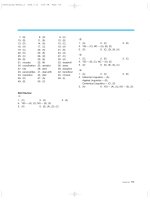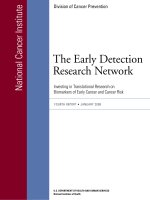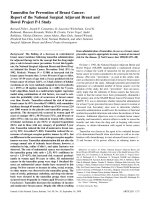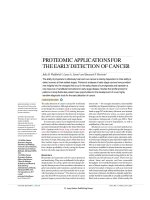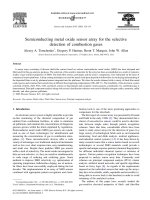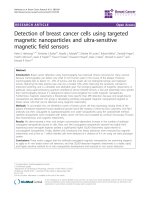Mammography and Beyond: Developing Technologies for the Early Detection of Breast Cancer pptx
Bạn đang xem bản rút gọn của tài liệu. Xem và tải ngay bản đầy đủ của tài liệu tại đây (1.81 MB, 311 trang )
Mammography and Beyond:
Developing Technologies for
the Early Detection of
Breast Cancer
Committee on Technologies for the Early Detection of Breast Cancer
Sharyl J. Nass, I. Craig Henderson, and Joyce C. Lashof, Editors
National Cancer Policy Board
INSTITUTE OF MEDICINE
and
Division of Earth and Life Studies
NATIONAL RESEARCH COUNCIL
NATIONAL ACADEMY PRESS
Washington, DC
NATONAL ACADEMY PRESS • 2101 Constitution Avenue, N.W. • Washington, DC 20418
NOTICE: The project that is the subject of this report was approved by the Insti-
tute of Medicine and the Governing Board of the National Research Council,
whose members are drawn from the councils of the National Academy of Sci-
ences, the National Academy of Engineering, and the Institute of Medicine. The
members of the committee responsible for the report were chosen for their special
competences and with regard for appropriate balance.
Support for this project was provided by the Breast Cancer Research Founda-
tion, the Carl J. Herzog Foundation, Mr. John K. Castle, the Jewish Healthcare
Foundation (Pittsburgh, PA), the Josiah Macy, Jr., Foundation, the Kansas Health
Foundation, and the New York Community Trust. The views presented in this
report are those of the Committee on Technologies for Early Detection of Breast
Cancer and are not necessarily those of the sponsors.
Library of Congress Cataloging-in-Publication Data
Mammography and beyond : developing technologies for the early detection of
breast cancer / Committee on the Early Detection of Breast Cancer ; Sharyl J.
Nass, I. Craig Henderson, and Joyce C. Lashof, editors ; National Cancer Policy
Board, Institute of Medicine and Commission on Life Sciences, National
Research Council.
p. ; cm.
Includes bibliographical references and index.
ISBN 0-309-07283-2
1. Breast—Cancer—Diagnosis. 2. Breast—Imaging. 3. Medical screening.
I. Nass, Sharyl J. II. Henderson, I. Craig. III. Lashof, Joyce C. IV. Institute of
Medicine (U.S.). Committee on the Early Detection of Breast Cancer. V. National
Cancer Policy Board (U.S.).
[DNLM: 1. Breast Neoplasms—diagnosis. 2. Mammography. 3. Mass
Screening. WP 870 M2649 2001]
RC280.B8 M29 2001
616.99′449075—dc21 2001030885
Additional copies of this report are available from the National Academy
Press, 2101 Constitution Avenue, N.W., Box 285, Washington, DC 20055. The full
text of this report is available on line at www.nap.edu.
For more information about the Institute of Medicine, visit the IOM home
page at www.iom.edu.
Copyright 2001 by the National Academy of Sciences. All rights reserved.
Printed in the United States of America.
COVER: Rosalie Ann Cassell, Waiting for the Biopsy, 1998. 18” x 22”. Watercolor
and ink. http:/www.breastcancerfund.org/gallery_6.html. Art. Rage. Us. The Art
and Outrage of Breast Cancer.
The National Academy of Sciences is a private, nonprofit, self-perpetuating soci-
ety of distinguished scholars engaged in scientific and engineering research, dedi-
cated to the furtherance of science and technology and to their use for the general
welfare. Upon the authority of the charter granted to it by the Congress in 1863,
the Academy has a mandate that requires it to advise the federal government on
scientific and technical matters. Dr. Bruce M. Alberts is president of the National
Academy of Sciences.
The National Academy of Engineering was established in 1964, under the charter
of the National Academy of Sciences, as a parallel organization of outstanding
engineers. It is autonomous in its administration and in the selection of its mem-
bers, sharing with the National Academy of Sciences the responsibility for advis-
ing the federal government. The National Academy of Engineering also sponsors
engineering programs aimed at meeting national needs, encourages education
and research, and recognizes the superior achievements of engineers. Dr. William
A. Wulf is president of the National Academy of Engineering.
The Institute of Medicine was established in 1970 by the National Academy of
Sciences to secure the services of eminent members of appropriate professions in
the examination of policy matters pertaining to the health of the public. The
Institute acts under the responsibility given to the National Academy of Sciences
by its congressional charter to be an adviser to the federal government and, upon
its own initiative, to identify issues of medical care, research, and education. Dr.
Kenneth I. Shine is president of the Institute of Medicine.
The National Research Council was organized by the National Academy of Sci-
ences in 1916 to associate the broad community of science and technology with
the Academy’s purposes of furthering knowledge and advising the federal gov-
ernment. Functioning in accordance with general policies determined by the Acad-
emy, the Council has become the principal operating agency of both the National
Academy of Sciences and the National Academy of Engineering in providing
services to the government, the public, and the scientific and engineering commu-
nities. The Council is administered jointly by both Academies and the Institute of
Medicine. Dr. Bruce M. Alberts and Dr. William A. Wulf are chairman and vice
chairman, respectively, of the National Research Council.
National Academy of Sciences
National Academy of Engineering
Institute of Medicine
National Research Council
v
COMMITTEE ON TECHNOLOGIES FOR THE EARLY DETECTION
OF BREAST CANCER
JOYCE C. LASHOF, M.D., FACP, CHAIR, Professor Emerita, School of
Public Health, University of California at Berkeley, Berkeley, CA
I. CRAIG HENDERSON, M.D., VICE CHAIR, Adjunct Professor of
Medicine, University of California at San Francisco, San Francisco,
CA
D. CRAIG ALLRED, M.D., Professor of Pathology, Baylor College of
Medicine, Houston, TX
WADE M. AUBRY, M.D., Vice President, The Lewin Group, Associate
Clinical Professor of Medicine, University of California at San
Francisco, San Francisco, CA
JANET K. BAUM, M.D., FACR, Associate Professor of Radiology,
Harvard Medical School, Director, Breast Imaging, Beth Israel
Deaconess Medical Center, Boston, MA
SUZANNE W. FLETCHER, M.D., M.Sc., Professor of Ambulatory Care
and Prevention, Harvard School of Medicine, Harvard Pilgrim
Health Care, Professor of Epidemiology, Harvard School of Public
Health, Boston, MA
MARTHE R. GOLD, M.D., M.P.H., Chair, Department of Community
Health and Social Medicine, City University of New York Medical
School, New York, NY
LEON GORDIS, M.D., D.P.H., Professor of Epidemiology, Johns
Hopkins School of Public Health & Hygiene, Baltimore, MD
DANIEL F. HAYES, M.D., Clinical Director, Breast Cancer Program,
Lombardi Cancer Center, Georgetown University Medical Center,
Washington, DC
CAROLINA HINESTROSA, M.A., Cofounder and Executive Director,
Nueva Vida, Silver Spring, MD
JEAN J. LATIMER, Ph.D., Investigator, Magee-Womens Research
Institute, Assistant Professor, Department of Obstetrics,
Gynecology, and Reproductive Sciences, University of Pittsburgh,
Pittsburgh, PA
RICHARD R. NELSON, Ph.D., George Blumenthal Professor, School of
International and Public Affairs, Columbia University, New York,
NY
KENNETH OFFIT, M.D., M.P.H., Chief, Clinical Genetics Service,
Department of Human Genetics, Memorial Sloan-Kettering Cancer
Center, New York, NY
FAINA SHTERN, M.D., Director, Office of Research Affairs,
Department of Radiology, Beth Israel-Deaconess Medical Center,
Harvard Medical School, Boston, MA
vi
MICHAEL W. VANNIER, M.D., Professor and Head, Department of
Radiology, University of Iowa College of Medicine, Iowa City, Iowa
DEREK VAN AMERONGEN, M.D., M.S., FACOG, Chief Medical
Officer, Humana/ Choice Care, Cincinnati, OH
Liaison for the National Cancer Policy Board
ROBERT DAY, M.D., M.P.H., Ph.D., Emeritus President and Director,
Fred Hutchinson Cancer Research Center, Seattle, WA
Consultants
LARRY NORTON, M.D., Chief, Solid Tumors, Memorial Sloan-
Kettering, New York, NY
BARRON LERNER, M.D., Ph.D, Assistant Professor of Medicine and
Public Health (in the Center for the Study of Society and Medicine),
Columbia University, New York, NY
Staff
SHARYL J. NASS, Ph.D., Study Director
ROBERT COOK-DEEGAN, M.D., Director, National Cancer Policy
Board (through August 2000)
ROGER HERDMAN, M.D., Director, National Cancer Policy Board
(from September 2000)
CARMIE CHAN, Research Assistant (through August 2000)
MARYJOY BALLANTYNE, Research Assistant (from August 2000)
BIANCA TAYLOR, Project Assistant
JOHN KUCEWICZ, Intern
KEVIN COLLINS, Intern
ELLEN JOHNSON, Administrative Assistant (through June 2000)
NICCI DOWD, Administrative Assistant (from August 2000)
GARY WALKER, Financial Associate (through September 2000)
JENNIFER CANGCO, Financial Associate (from September 2000)
Commissioned Writers
(for lay summaries of the report, workshop proceedings, and current
practice in breast cancer diagnosis)
MARGIE PATLAK
(see />Breast+Cancer+Detection)
LAURA NEWMAN, M.A.
(see and http://
www.nap.edu/catalog/10011.html)
vii
THE NATIONAL CANCER POLICY BOARD
ARNOLD J. LEVINE, Ph.D. CHAIR, President, The Rockefeller
University, New York, NY
JOSEPH V. SIMONE, M.D. VICE-CHAIR, Medical Director, Huntsman
Cancer Institute, Salt Lake City, UT
ELLEN STOVALL, VICE-CHAIR, Executive Director, National
Coalition for Cancer Survivorship, Silver Spring, MD
DIANA PETITTI, M.D., VICE-CHAIR, Director, Research & Evaluation,
Kaiser Permanente of Southern California, Pasadena, CA
TIM BYERS, M.D., M.P.H., Professor of Epidemiology, University of
Colorado, Denver, CO
VIVIAN WAI-MEI CHEN, Ph.D., Chief & Professor of Epidemiology,
Louisiana State University, New Orleans, LA
SUSAN J. CURRY, Ph.D., Director, Center for Health Studies, Group
Health of Puget Sound, Seattle, WA
NORMAN DANIELS, Ph.D., Professor of Philosophy, Tufts University,
Newton, MA
KATHLEEN M. FOLEY, M.D., Chief of Pain Service, Memorial Sloan-
Kettering Cancer Center, New York, NY
THOMAS KELLY, M.D., Ph.D., Chairman of Department of Molecular
Biology & Genetics, Johns Hopkins University, Baltimore, MD
MARK MCCLELLAN, Assistant Professor of Economics, Stanford
University, Stanford, CA
WILLIAM MCGUIRE, M.D., Chairman and CEO, United Health
Group, Minnetonka, MN
JOHN MENDELSOHN, M.D., President, University of Texas,
Houston, TX
MONICA MORROW, M.D., Professor of Surgery, Northwestern
University, Chicago, IL
NANCY MUELLER, Sc.D, Professor of Epidemiology, Harvard School
of Public Health, Boston, MA
PILAR N. OSSORIO, Ph.D., J.D., Assistant Professor, University of
Wisconsin Law School, Madison, WI
CECIL B. PICKETT, Ph.D., Executive Vice President, Discovery
Research, Kenilworth, NJ
JOHN SEFFRIN, Ph.D., CEO, American Cancer Society, Atlanta, GA
SANDRA M. UNDERWOOD, RN, PH.D FAAN, ACS Oncology
Nursing Professor, University of Wisconsin, Milwaukee, WI
FRANCES VISCO, President, National Breast Cancer Coalition,
Washington, DC
SUSAN WIENER, Ph.D., President, The Children’s Cause, Silver
Spring, MD
National Cancer Policy Board Staff
ROGER HERDMAN, Director (from September 2000)
ROBERT COOK-DEEGAN, Director (through August 2000)
MARIA HEWITT, Senior Program Officer
HELLEN GELBAND, Senior Program Officer
SHARYL NASS, Program Officer
MARYJOY BALLANTYNE, Research Assistant
BIANCA TAYLOR, Project Assistant
NICCI DOWD, Administrative Assistant
viii
ix
Reviewers
This report has been reviewed in draft form by individuals chosen for
their diverse perspectives and technical expertise, in accordance with pro-
cedures approved by the NRC’s Report Review Committee. The purpose
of this independent review is to provide candid and critical comments
that will assist the institution in making its published report as sound as
possible and to ensure that the report meets institutional standards for
objectivity, evidence, and responsiveness to the study charge. The review
comments and draft manuscript remain confidential to protect the integ-
rity of the deliberative process. We wish to thank the following individu-
als for their review of this report:
Thomas F. Budinger, M.D., Ph.D., Head, Center for Functional
Imaging, E.O. Lawrence Berkeley National Laboratory
Webster K. Cavanee, Ph.D., Director, Laboratory of Tumor Biology,
Ludwig Institute for Cancer Research, University of California-San
Diego
Joann G. Elmore, Ph.D., Assistant Professor, Department of Medicine,
University of Washington
Samuel Hellman, M.D., A.N. Pritzker Distinguished Service Professor,
Center for Advanced Medicine, The University of Chicago
Barbara J. McNeil, M.D., Ph.D., Professor and Head, Department of
Health Care Policy, Harvard Medical School
Susan Scherr, Director, Survivorship Programs, National Coalition for
Cancer Survivorship, Silver Spring, MD
x REVIEWERS
Although the reviewers listed above have provided many construc-
tive comments and suggestions, they were not asked to endorse the con-
clusions or recommendations nor did they see the final draft of the report
before its release. The review of this report was overseen by Barbara
Hulka, M.D., M.P.H., Kenan Professor, Department of Epidemiology,
University of North Carolina at Chapel Hill, appointed by the Institute of
Medicine, and Mary Jane Osborn, Ph.D., Department of Microbiology,
University of Connecticut Health Center, appointed by the NRC’s Report
Review Committee, who were responsible for making certain that an in-
dependent examination of this report was carried out in accordance with
institutional procedures and that all review comments were carefully con-
sidered. Responsibility for the final content of this report rests entirely
with the authoring committee and the institution.
Preface
xi
Breast cancer remains a leading cause of cancer death among women
in the United States. More than 180,000 new cases of invasive breast
cancer are diagnosed each year, and more than 40,000 women die of the
disease. Recent years, however, have seen improvements in survival
attributed to better treatment and earlier diagnosis. Research efforts have
been directed toward better treatment, preventive strategies, and early
detection. Although mammography has been the mainstay of early de-
tection, its limitations are well recognized and the search for more effec-
tive technologies for early detection has been receiving increased atten-
tion. As part of this increased attention, the Institute of Medicine (IOM)
convened a committee to examine the current state of the art in early
breast cancer detection, to identify promising new technologies, and to
examine the many steps in medical technology development and the poli-
cies that influence their adoption and use. The IOM committee consisted
of a 16-member interdisciplinary group with a wide range of views and
expertise in breast cancer, medical imaging, cancer biology, epidemiol-
ogy, economics, and technology assessment. The committee examined
the peer-reviewed literature, met four times, held two workshops that
dealt with new technologies as well as policies related to their adoption
and dissemination, and consulted with experts in the field.
Early detection is widely believed to save lives by facilitating inter-
vention early in the course of the disease, at a stage when cancer treat-
ment is most likely to be effective. This concept, however, belies a num-
ber of complexities, not the least of which is the need to understand the
xii PREFACE
basic biology of breast cancer. The committee recognized the need for
research on the natural history of breast cancer to more clearly define the
significance of early lesions, the need for the development of biomarkers,
and the importance of assessing the effectiveness of new technologies in
decreasing morbidity and mortality. This report describes many novel
technologies that are being developed for the purpose of early breast
cancer detection, as well as recent technological advances in detection
modalities already in use. Because the many technologies that the com-
mittee examined were at different stages of development and thus the
evidence of their accuracy and effectiveness varied, the committee found
it difficult to predict which of the many new technologies were likely to
play a role in the future of early breast cancer detection.
The committee also identified a number of barriers to both the devel-
opment and the dissemination of new technologies and made recommen-
dations for actions that can be taken to overcome them. Many new tech-
nologies are on the horizon and intriguing research in basic biology is
under way, but much remains to be done. We are hopeful that this report
will contribute in some small way to the efforts to improve our ability to
detect breast cancer at an early stage. The committee was impressed with
the dedication and commitment of the researchers in both the public
and the private sectors and with the governmental personnel working to
save the lives of women, and we are hopeful that their efforts will prove
fruitful.
Joyce C. Lashof
Chair
Acknowledgments
xiii
The committee wishes to thank all of the people who contributed to
this report. First and foremost we wish to acknowledge the outstanding
work of the study director, Sharyl Nass. Sharyl was responsible for the
extensive literature search, for selecting an outstanding group of speakers
for the two workshops, as well as preparing the initial drafts and revi-
sions of the entire report. Her ability to identify the key issues as well as
the key players was instrumental in carrying out the work of the commit-
tee. She was responsive to the committee members throughout, and we
all found it a pleasure to work with her. We also thank Carmie Chan and
MaryJoy Ballantyne who provided invaluable research assistance. We
were further assisted by two interns, John Kucewicz and Kevin Collins,
who made substantial contributions to the completion of Chapters 2 and
6, respectively. We also appreciate the efforts of Bianca Taylor, who took
primary responsibility for organizing the logistics of all the committee
meetings and workshops and who was very helpful in keeping the study
on schedule. The senior staff of the National Cancer Policy Board (Roger
Herdman, Robert Cook-Deegan, Maria Hewitt, and Hellen Gelband) all
provided valuable feedback on drafts of the report.
We also wish to thank all of the workshop speakers and participants,
as well as a host of others who contributed to the study by speaking at
meetings or by providing data and other written materials. The names
and affiliations of all the speakers and other contributors are listed in
Appendix A.
All of the committee members gave generously of their time and were
xiv ACKNOWLEDGMENTS
important collaborators throughout the deliberations and preparation of
the report. Several members made primary contributions in drafting the
report, and are noted for their efforts as follows: Chapter 1, Daniel Hayes;
Chapter 2, Janet Baum and Michael Vannier; Chapter 3, Craig Allred, Jean
Latimer, and Kenneth Offitt; Chapter 5, Suzanne Fletcher, Marthe Gold,
Derek Van Amerongen, and Wade Aubry. In addition, Carolina
Hinestrosa provided valuable and insightful comments that were incor-
porated into all the chapters of the report. We also thank Craig
Henderson, vice-chair of the committee, for his thoughtful advice and
insight throughout.
Finally, we owe a debt of gratitude to the seven independent founda-
tions and individuals who provided the funds needed to undertake this
study. This report could not have been produced were it not for the
generosity of the Breast Cancer Research Foundation, the Carl J. Herzog
Foundation, Mr. John K. Castle, the Jewish Healthcare Foundation, the
Josiah Macy, Jr., Foundation, the Kansas Health Foundation, and the New
York Community Trust.
Acronyms
xv
ABBI advanced breast biopsy instrumentation
ABR American Board on Radiology
ACRIN American College of Radiology Imaging Network
ACS American Cancer Society
AHRQ Agency for Healthcare Research and Quality
ART Advanced Research and Technology
AT ataxia telangiectasia
ATP Advanced Technology Program
BBE Biofield Breast Examination
BCBSA Blue Cross/Blue Shield Association
BC-PRG Breast Cancer Progress Review Group
BCRP Breast Cancer Research Program
BCSC Breast Cancer Surveillance Consortium
BIRADS Breast Imaging Reporting and Data System
BISTIC Biomedical Information Science and Technology
Implementation Consortium
BRCA breast cancer-associated tumor suppressor gene
BSE breast self-examination
CAD computer-aided detection or diagnosis
CBE clinical breast examination
CDC Centers for Disease Control and Prevention
cDNA complementary deoxyribonucleic acid
CEA carcinoembryonic antigen
CGAP Cancer Genome Anatomy Project
xvi ACRONYMS
CIA Central Intelligence Agency
CLIA Clinical Laboratory Improvement Amendments
CNB core-needle biopsy
CPTA Center for Practice and Technology Assessment
DOD U.S. Department of Defense
EITS electrical impedance tomography system
EPC evidence-based practice centers
ESS elastic scattering spectroscopy
FDA Food and Drug Administration
FDAMA Food and Drug Administration Modernization Act
FFDM Full-field digital mammography
FISH fluorescent in situ hybridization
FNA fine-needle aspiration
FNAB fine-needle aspiration biopsy
FSM film-screen mammography
GAO General Accounting Office
HCFA Health Care Financing Administration
HEI Hall effect imaging
HGRI National Human Genome Research Institute
HIP Health Insurance Plan of Greater New York
HMEC human mammary epithelial cells
HRSA Health Resources and Services Administration
IBC invasive breast cancer
IDE investigational device exemption
IGF1 insulin-like growth factor type 1
IMDS Imaging Diagnostic System, Inc.
IOM Institute of Medicine
IRB institutional review board
LCIS lobular carcinoma in situ
LOH loss of heterozygosity
MCAC Medicare Coverage Advisory Committee
MIBI technetium-99m sestamibi
MMG magnetomammography
MQSA Mammography Quality Standards Act of 1976
MRI magnetic resonance imaging
ACRONYMS xvii
mRNA messenger ribonucleic acid
MRS magnetic resonance spectroscopy
NAF nipple aspiration fluid
NCHCT National Center for Health Care Technology
NCI National Cancer Institute
NEMA National Electrical Manufacturers’ Association
NIH National Institutes of Health
NIST National Institute of Standards and Technology
NMD National Mammography Database
OBBB Office of Bioengineering, Bioimaging, and Bioinformatics
OTA Office of Technology Assessment
OWH Office on Women’s Health
PCR polymerase chain reaction
PET positron emission tomography
PMA premarketing approval
PPV positive predictive value
PSA Prostate specific antigen
PTEN tumor suppressor gene
QALY quality-adjusted life year
RCP riboflavin carrier protein
RNA ribonucleic acid
RO1 a type of grant from the National Institutes of Health
RT reverse transcription
RVU relative value unit
SACGT Secretary’s Advisory Committee on Genetic Testing
SBI Society of Breast Imaging
SBIR Small Business Innovative Research
SNP single nucleotide polymorphism
SPECT Single-photon emission computed tomography
SQUID superconducting quantum interference device
STTR Small Business Technology Transfer Research
TACT tuned aperture computed tomography
TCT thermoacoustic computed tomography
TEC Technology Evaluation Center
USAMRMC U.S. Army Medical Research and Materiel Command
USPSTF U.S. Preventive Services Task Force
Contents
Executive Summary 1
1 Introduction 15
2 Breast Imaging and Related Technologies 55
3 Technologies in Development: Genetics and Tumor Markers 105
4 Development and Regulation of New Technologies 133
5 Evaluation and Cost Coverage of New Technologies 167
6 Dissemination: Increasing the Use and Availability of
New Technologies 199
7 Findings and Recommendations 221
Glossary 237
References 249
Appendix: Workshop speakers and other contributors 269
Index 273
xix
Mammography and Beyond:
1
Executive Summary
Breast cancer takes a tremendous toll in the United States. After lung
cancer, breast cancer is the second leading cause of death from cancer
among women in the United States and is the most common non-skin-
related malignancy among U.S. women. Each year, more than 180,000
new cases of invasive breast cancer are diagnosed and more than 40,000
women die from the disease. Until research uncovers a way to prevent
breast cancer or to cure all women regardless of when their tumors are
found, early detection will be looked upon as the best hope for reducing
the burden of this disease. The hope is that early detection of breast cancer
by screening could be as effective at saving lives as the Papanicolaou
smear (Pap smear) used for cervical cancer screening.
Early detection is widely believed to reduce breast cancer mortality
by allowing intervention at an earlier stage of cancer progression. Clinical
data show that women diagnosed with early-stage breast cancers are less
likely to die of the disease than those diagnosed with more advanced
stages of breast cancer. A thorough annual physical breast examination
and monthly breast self-examination can often detect tumors that are
smaller than those found in the absence of such examinations, but data on
the ability of physical examinations alone to reduce breast cancer mortal-
ity are limited. X-ray mammography, with or without a clinical examina-
tion, has been shown in randomized clinical trials both to detect cancer at
an earlier stage and to reduce disease-specific mortality. As a result,
screening mammography has secured a place as part of routine health
maintenance procedures for women in the United States. The mortality
2 MAMMOGRAPHY AND BEYOND
rate from breast cancer has been decreasing in the United States by about
2 percent per year over the last decade, suggesting that early detection
and improved therapy are both having an impact on the disease.
Mammography is not perfect, however. Routine screening in clinical
trials resulted in a 25 to 30 percent decrease in breast cancer mortality
among women between the ages of 50 and 70. A lesser benefit was seen
among women ages 40 to 49. The benefit of screening mammography for
women over age 70 is more difficult to assess because of a lack of data for
this age group from randomized clinical trials. Screening mammography
cannot eliminate all deaths from breast cancer because it does not detect
all cancers, including some that are detected by physical examination.
Some tumors may also develop too quickly to be identified at an early,
“curable” stage using the standard screening intervals. Furthermore, it is
technically difficult to consistently produce mammograms of high qual-
ity, and interpretation is subjective and can be variable among radiolo-
gists. Mammograms are particularly difficult to interpret for women with
dense breast tissue, which is especially common in young women. The
dense tissue interferes with the identification of abnormalities associated
with tumors, leading to a higher rate of false-positive and false-negative
test results among these women. These difficulties associated with dense
tissue are especially problematic for young women with heritable muta-
tions who wish to begin screening at a younger age than what is recom-
mended for the general population.
Mammography can also have deleterious effects on some women, in
the form of false-positive results and overdiagnosis and overtreatment.
As many as three-quarters of all breast lesions that are biopsied as a result
of suspicious findings on a mammogram, turn out to be benign; that is,
the mammographic findings were falsely positive. (Many tissue biopsies
performed on lumps found by physical examination are also benign, but
the false-positive rate for physical examination has not been carefully
studied.) “Overdiagnosis” is the labeling of small lesions as cancer or
precancer when in fact the lesions may never have progressed to a life-
threatening disease if they had been left undetected and untreated. In
such cases, some of the “cures” that occur after early detection may not be
real, and thus, such women are unnecessarily “overtreated.” Technical
improvements in breast imaging techniques have led to an increase in the
rate of detection of these small abnormalities, such as carcinoma in situ,
the biology of which is not well understood. Currently, the methods for
classification of such lesions detected by mammography are based on the
appearance of the tissue structure, and the ability to determine the lethal
potential of breast abnormalities from this classification is crude at best.
The immense burden of breast cancer, combined with the inherent
limitations of mammography and other detection modalities, have been
the driving forces behind the enormous efforts that have been and that

